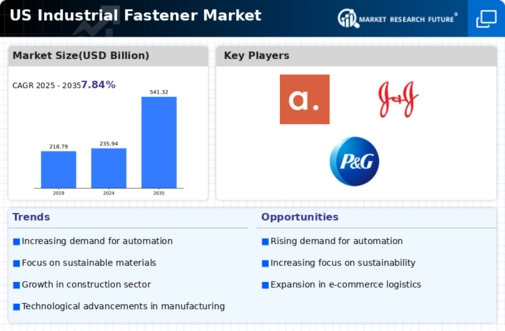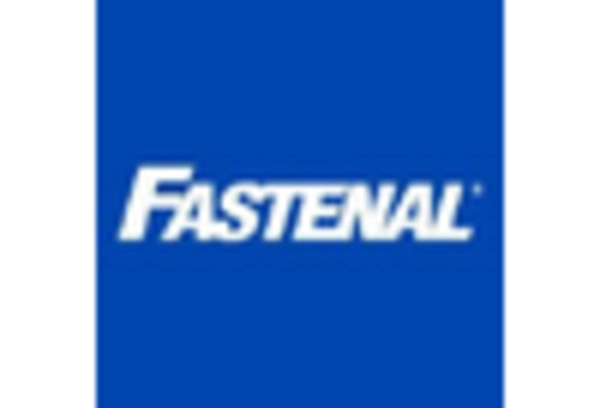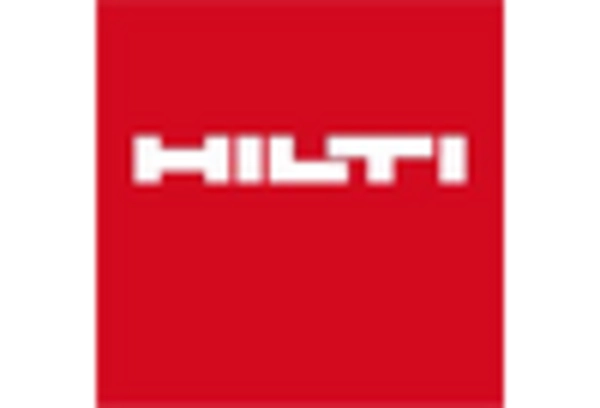Growth in Renewable Energy Projects
The renewable energy sector in the US is expanding rapidly, which appears to be a significant driver for the industrial fasteners market. With an increasing number of wind and solar energy projects being initiated, the demand for fasteners used in these installations is likely to rise. The US government has set ambitious targets for renewable energy, aiming for 50% of electricity generation to come from renewable sources by 2030. This shift necessitates the use of reliable fasteners that can withstand harsh environmental conditions. As a result, the industrial fasteners market may experience growth driven by the need for specialized fasteners in renewable energy applications. This trend suggests that stakeholders in the fasteners industry should align their strategies with the evolving energy landscape.
Expansion of Automotive Manufacturing
The automotive manufacturing sector in the US is undergoing a transformation, which seems to be positively influencing the industrial fasteners market. With the rise of electric vehicles (EVs) and advancements in automotive technology, the demand for specialized fasteners is likely to increase. The automotive industry is projected to grow at a CAGR of approximately 3.2%, leading to a heightened need for durable and lightweight fasteners. These components are critical for vehicle assembly, ensuring safety and performance. As manufacturers seek to enhance vehicle efficiency and reduce weight, the industrial fasteners market may see a shift towards innovative materials and designs. This evolution in automotive manufacturing underscores the importance of fasteners in achieving industry goals, indicating a promising outlook for the industrial fasteners market.
Rising Demand from Construction Sector
The construction sector in the US is experiencing a robust resurgence, which appears to be a primary driver for the industrial fasteners market. With the projected growth rate of the construction industry estimated at around 4.5% annually, the demand for fasteners is likely to increase correspondingly. Fasteners are essential components in various construction applications, including structural frameworks, roofing, and interior fittings. As infrastructure projects gain momentum, the industrial fasteners market is expected to benefit significantly. Furthermore, the increasing focus on building safety and quality standards necessitates the use of high-quality fasteners, which could further propel market growth. This trend indicates a strong correlation between construction activities and the industrial fasteners market, suggesting that stakeholders should closely monitor developments in this sector.
Increased Focus on Quality and Standards
The industrial fasteners market is likely to be driven by an increased focus on quality and compliance with industry standards. As industries such as aerospace, automotive, and construction prioritize safety and reliability, the demand for high-quality fasteners is expected to rise. Regulatory bodies in the US are enforcing stricter standards for fasteners, which may compel manufacturers to enhance their quality control processes. This trend suggests that companies investing in quality assurance and certification may gain a competitive edge in the industrial fasteners market. Additionally, the emphasis on quality could lead to a consolidation of suppliers, as customers seek reliable partners who can meet stringent requirements. This evolving landscape indicates that quality will play a crucial role in shaping the future of the industrial fasteners market.
Technological Innovations in Manufacturing
Technological innovations in manufacturing processes are likely to have a profound impact on the industrial fasteners market. The adoption of advanced manufacturing techniques, such as 3D printing and automated assembly, appears to enhance the efficiency and precision of fastener production. These innovations may lead to a reduction in production costs and an increase in product quality, which could attract more customers to the industrial fasteners market. Furthermore, the integration of smart technologies in manufacturing is expected to streamline operations and improve supply chain management. As manufacturers embrace these advancements, the industrial fasteners market may witness a shift towards more customized and high-performance products, indicating a dynamic evolution in the industry.

















Leave a Comment